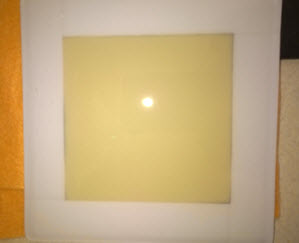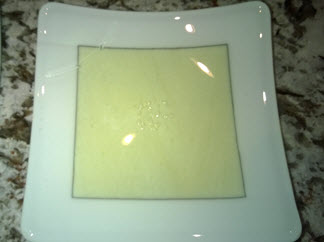Page 1 of 1
Inconsistent Reaction Results: French Vanilla and Dense White
Posted: Tue Dec 08, 2015 10:34 am
by David Jenkins
I am having a frustrating time trying to get consistent reaction results between Fr. Vanilla and Dense White. Sometimes I'll get a very crisp line between strips of DW and FV, and other times no visible reaction at all. My layup consists of a bottom layer that's a 4" FV square, surrounded by pinwheeled 1" strips of DW. This layer is capped with Tekta. I have tried various combinations of kilns and process temps - has anyone broken the code on this?
My next try will be to simply refire a blank and see if the added heatwork causes increased reactive activity. Any other suggestions the group can offer?
This is a very precise layup, and the strips and square are almost perfectly adjoined. I'm wondering: does the reaction depend on having some miniscule amount of space between the glasses?
Also wondering: Could different sheets of either of the glasses exhibit different reactive properties?
(And I'm absolutely positive that I'm using BE Dense White.)
Re: Inconsistent Reaction Results: French Vanilla and Dense White
Posted: Tue Dec 08, 2015 10:54 am
by Brad Walker
Don't know about the dense white, but different sheets of french vanilla can definitely behave differently. Different parts of the same sheet can also behave differently.
Re: Inconsistent Reaction Results: French Vanilla and Dense White
Posted: Tue Dec 08, 2015 11:25 am
by David Jenkins
Thanks, Brad - that may indeed be what's going on. I have multiple tries at this, and I do see that the FV elements have different hues from piece to piece.
Re: Inconsistent Reaction Results: French Vanilla and Dense White
Posted: Tue Dec 08, 2015 3:13 pm
by David Jenkins
Update: Put a previously fired blank in for a refuse. The blank showed just a faint, or no, line at the joint between the FV and DW. Decided to raise the process temp to 1490 from 1475, just for the hell of it. I checked on progress through the kiln's peephole when the fuse was on the way up, at around 1400. Guess what? It had already developed a very nice, even, reaction line at the glass junctions.
I guess I don't understand - why would reheating cause the reaction to intensify?
Re: Inconsistent Reaction Results: French Vanilla and Dense White
Posted: Tue Dec 08, 2015 3:31 pm
by Brad Walker
David Jenkins wrote:I guess I don't understand - why would reheating cause the reaction to intensify?
Reactions show up due to heat. If you heat higher, the reaction gets stronger. If you fire twice, its gets more heat so it reacts stronger. If you fire a third time, it will intensify even more.
Re: Inconsistent Reaction Results: French Vanilla and Dense White
Posted: Wed Dec 09, 2015 11:54 pm
by jim simmons
Heat work
The other Jim
Re: Inconsistent Reaction Results: French Vanilla and Dense White
Posted: Thu Dec 10, 2015 6:01 pm
by Valerie Adams
Reactions do intensify with additional firings/heatwork. Take Opaline, for instance: it'll slightly opacify with a single firing, but become more and more opal with additional firings. I believe Bullseye has other tip sheets besides this one:
http://www.bullseyeglass.com/methods-id ... asses.html
Re: Inconsistent Reaction Results: French Vanilla and Dense White
Posted: Thu Dec 10, 2015 10:48 pm
by Morganica
Reactions will intensify and eventually even out...to a point. Usually that's the point at which the reaction potential has been exhausted, or the crystal growth has maxed out, or the glass has just basically used up whatever it is that's causing the reaction in the first place. So your choice--if you want an even reaction--is usually to max it out.
I did a series of tack-fuses awhile back in a Skutt bathtub kiln using an ivory-colored glass that struck warm grey. I made a series of strip bowls with this stuff, and kept the tack-fuses fairly light. You could see the heat patterns in the kiln--and the placement of the molds--in the patterns made by the striking colors. The parts of the strips closest to the elements showed the darkest color; the material that was most insulated and farthest from the elements retained near-ivory color.
...Which makes me want to ask if there's any pattern or consistency in your reaction results? Are you getting more consistent dark stripes toward the edges? The centers? It could be, especially if you're trying to keep your lines very sharp by doing a flip-n-fire, that you're not applying enough heatwork to ensure an even level of reaction across the strips. Hard to tell without pics...
Re: Inconsistent Reaction Results: French Vanilla and Dense White
Posted: Fri Dec 11, 2015 6:17 pm
by David Jenkins
I think I'm not trying to do anything as complex as what I think you're describing, Cynthia. Here are two pics - they are not of the same piece, but they show what was going on.
The first is a piece after my normal fuse schedule for this kind of item in my Caldera - FAP from 1250 to 1480, hold 10:

- WP_20151208_002.jpg (7.17 KiB) Viewed 13709 times
And here is what it looks like after I've run it through that same schedule a second time:

- WP_20150531_062.jpg (11.52 KiB) Viewed 13709 times
Even now, as we speak, I've got a test in the kiln with a slower ramp to process, and a longer hold. Hopefully, that'll produce the results I'm after in a single trip.
[time passes ...]
And here are the results of that test:
Re: Inconsistent Reaction Results: French Vanilla and Dense White
Posted: Thu Dec 17, 2015 1:00 pm
by Havi
Brad Walker wrote:David Jenkins wrote:I guess I don't understand - why would reheating cause the reaction to intensify?
Reactions show up due to heat. If you heat higher, the reaction gets stronger. If you fire twice, its gets more heat so it reacts stronger. If you fire a third time, it will intensify even more.
It happened to me also. I was firing turquoise with reactive, it was supposed to become black. It happened on the Second firing, not the first!
HAvi